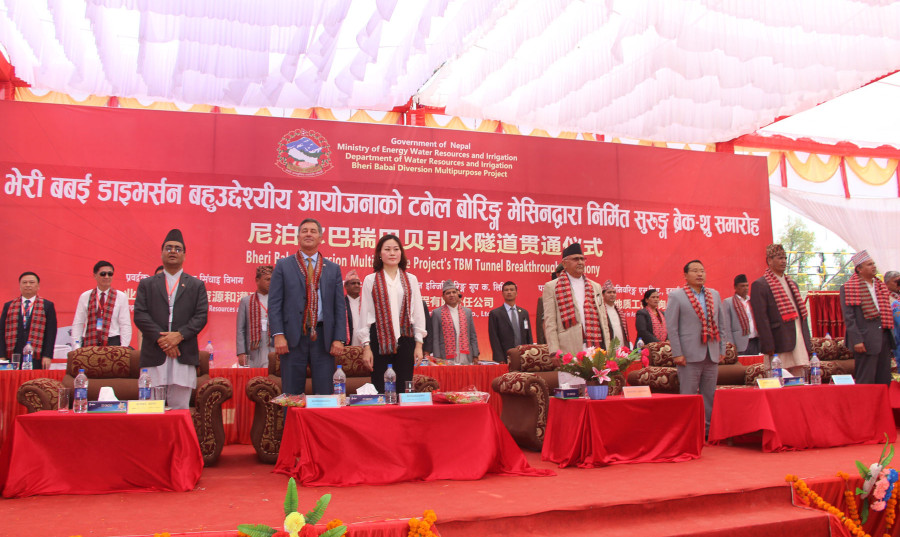Money
Early breakthrough in Bheri Babai tunnel sets a milestone--and a lesson for other lagging national projects
The tunnel with a capacity to divert 40 cubic metres of water per second will be used to irrigate 51,000 hectares of land throughout the year in Banke and Bardia districts and generate 46 megawatt electricity.
Prahlad Rijal
The Rs33.18 billion Bheri Babai Diversion Multipurpose Project in Surkhet has crossed a major milestone with the completion of a tunnelled connection, allowing diversion of water from Bheri River to Babai River for irrigation and power generation.
Four years after the national pride project was inaugurated by the late Sushil Koirala in April 2015, the Bheri Babai project marked the tunnel breakthrough one year before the original deadline—thanks to a number of factors, including the use of technology, topography and well-coordinated efforts.
Prime Minister KP Sharma Oli turned on the switch on Tuesday to mark the final breakthrough of the tunnel.
In a first, the 12-km tunnel was dug using a tunnel boring machine built and installed by a US-based manufacturer. The civil contractor for the project is China Overseas Engineering Group.
Oli described the project as a great example of global partnership in development, saying the achievement was a result of the synergy between a Chinese construction company, American technology and Nepali manpower.
With this, the major Rs10.57 billion tunnel component of one of the major strategic projects of the country, which is expected to ease the food crisis in the mid-western region by increasing agricultural yield, has been completed. The second component—hydroelectricity and other structures worth Rs12.10 billion—is expected to begin a few months from now.
The tunnel with a capacity to divert 40 cubic metres of water per second will be used to irrigate 51,000 hectares of land throughout the year in Banke and Bardia districts and generate 46 megawatt electricity.
Although the government had invited bids in July 2012, lack of resources and delay in contractor appointment had pushed the project inauguration to April 2015.
“But a number of factors contributed to early completion of the tunnel,” Sanjeeb Baral, chief of the project, told the Post. “Certainly the use of tunnel boring machine played a crucial role, as the conventional method—drill and blast—would have taken much longer to achieve the tunnel breakthrough. The contractor and the crew also worked in their full capacity to deal with the geological challenges.”
The construction site is located in the Siwalik Range, part of the Southern Himalayan mountains. Geology in this area consists mainly of sandstone, mudstone and conglomerate rocks.
Ram Prasad Ghimire, deputy director general at the Department of Mines and Geology, termed the tunnel progress a major feat given the geography of the area.
“Siwalik rocks are loose and they are of sedimentary origin. These rocks are easily breakable, but during tunnel excavation, this very nature of the rocks can pose a challenge as they can fall unexpectedly hindering the process,” Ghimire told the Post.
The Bheri Babai Diversion Multipurpose Project, a government undertaking, in the next phase aims to generate electricity by the fiscal year 2022-23.
According to Baral, the project invited bids for the construction of a powerhouse, headwork structure of the hydroelectricity scheme and other project components in January. Works on the scheme with a cost of Rs2.84 billion are expected to begin from July.
The hydro-mechanical component of the project is expected to get off the ground from August at an estimated cost of Rs3.51 billion.
Due to the delay in contractor appointment and lack of resources, the estimated cost of the project ballooned to Rs33 billion, double the original estimate of Rs16 billion.
The project is expected to make an indirect financial contribution of Rs3.1 billion annually to the state through irrigation and a direct revenue contribution of Rs2.1 billion through electricity sales.
As it is a government-owned project, it does not have to acquire electricity generation licence from the Department of Electricity Development, and it can begin constructing the hydroelectricity scheme immediately after appointing a contractor.
Project officials are planning to complete the procurement process and appoint the contractor for the second component by the end of this fiscal year.
An early breakthrough in the tunnel has been hailed by many, saying it can be a good lesson for the country while carrying out development projects in the future.
“The lesson that other projects need to learn is the selection of proper technology and contract design in accordance with the technology matters the most for the execution of any project,” Anup Kumar Upadhyay, a former secretary at the Ministry of Energy, told the Post.
“Technology definitely played a crucial role, but that aside, the contract was not divided into many portions and contractors were selected accordingly,” said Upadhyay. “More importantly, the project was free from bureaucratic hassles and issues that cropped up at the construction site were resolved then and there.”
Kalendra Sejuwal contributed reporting from Surkhet.




 6.12°C Kathmandu
6.12°C Kathmandu














